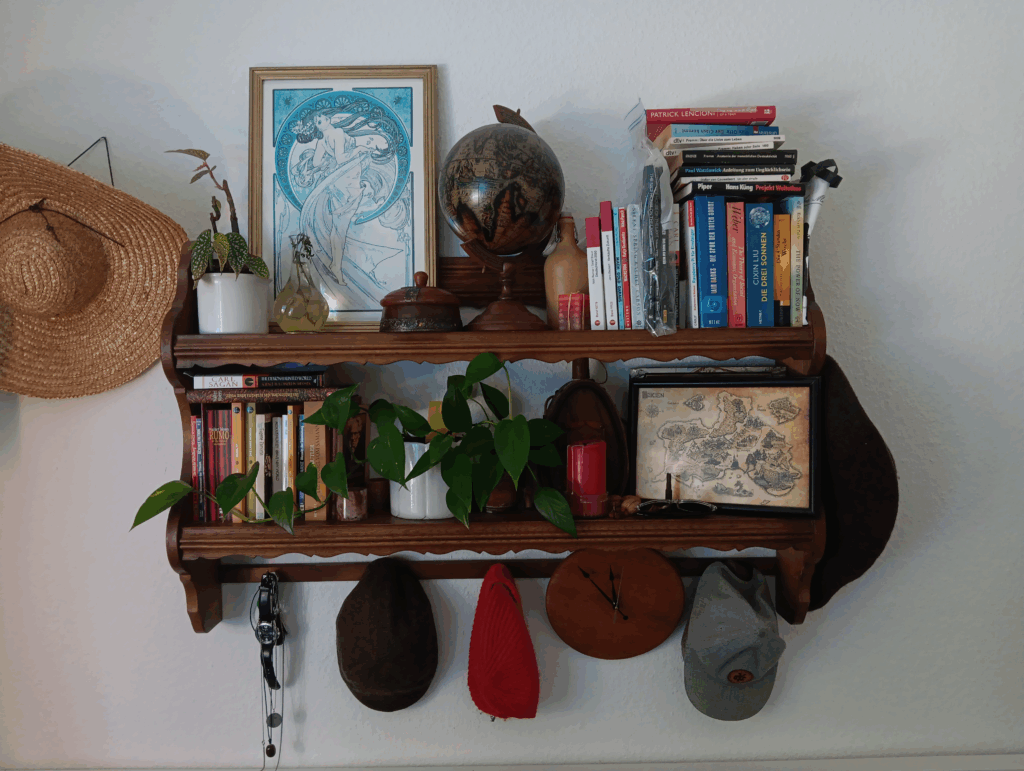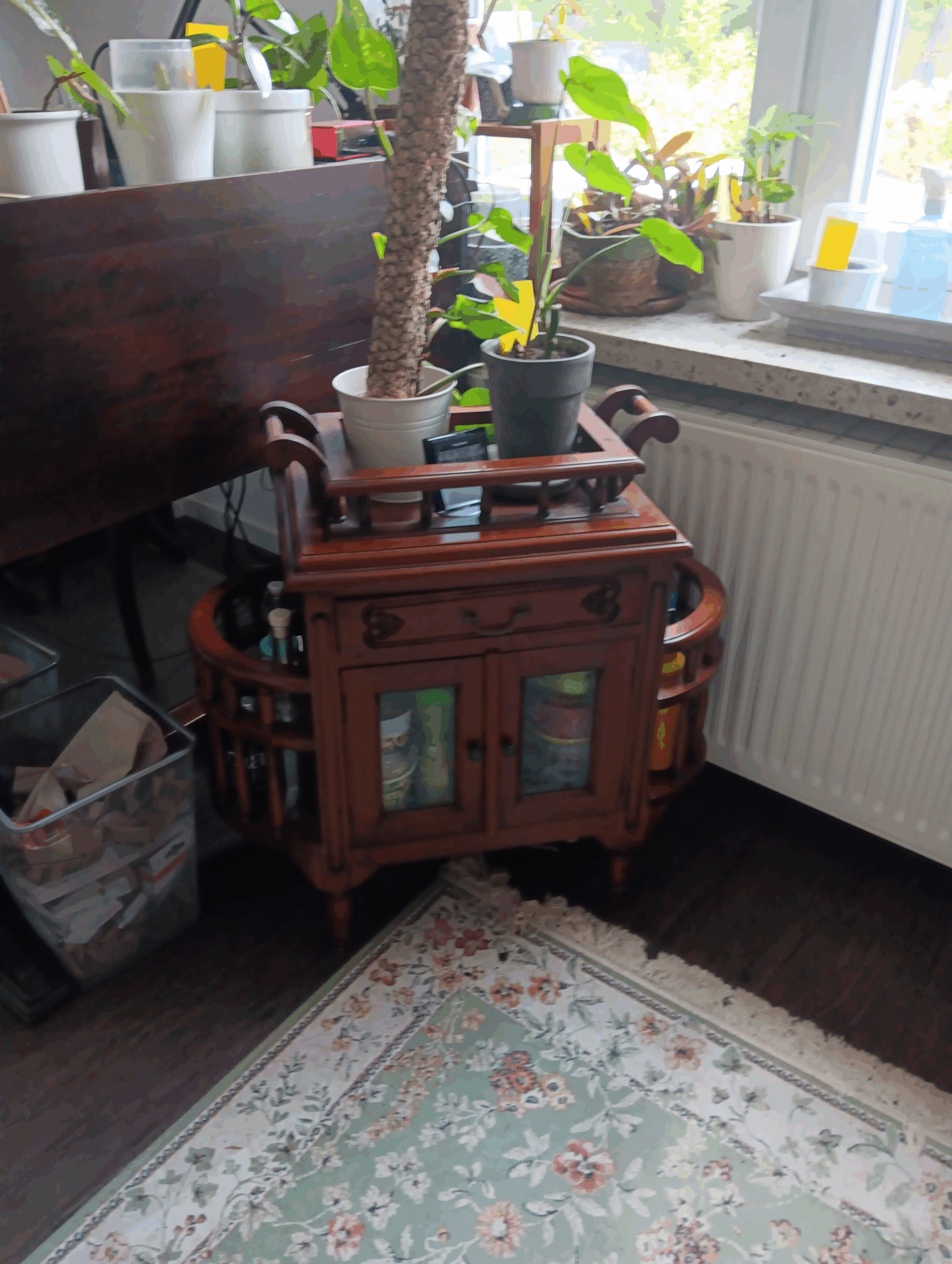How I turned 9 sqm. into my Solarpunk dream room.
So, you want to really get into Solarpunk – and now you want to solarpunkify your home.
But how do you go about it? I chose to loosely follow the SADIMET framework.
SADIMET originally is a framework used by permaculturists, and is used a guideline in the designprocess of permacultural sites. The name SADIMET stands for Survey, Analyse, Design, Implement, Maintain, Evaluate and Tweak – and by following these steps, one can design a space with more intention. Here’s how I used it:
SURVEY YOUR NEEDS
Before you go and get some inspiration, you might want to think about how your stylistic choices might impact your daily life: You are easily distracted, neurodivergent or simply hate cleaning? Step away from overly cluttered styles, and choose more calming pastel colors. You often feel depressed or like you can’t make a change in the world? Embrace DIY culture and bold colours. Living in a big city with little green, but you hate bugs? Spruce up your room with hydroponics.
Besides your personal needs, wants and responsibilities, you should also consider the function and the surroundings of the room you want to solarpunkify. Following the principles of interior design systems like Feng Shui (thanks Mr. Cliff Tan!) and color theory can help you foster a better understanding of your surroundings and lead to better choices.
ANALYSE YOUR SITUATION
This step is grounding your solarpunk fantasy in your current reality. Sure, you might want to live in a super sustainable communal cottage, or in a hightech biodynamic arcology. But this is not about what we want for us in the future, but about what we can do now. At the time of writing this blog post, I’m living in a shared flat with 4 other tenants, and I have only 9 square metres of personal space – not a lot of room. While my lifestyle involves working and spending time at different places (e.g. the TRAFOS or the library), I still spend a lot of time in this room. And while its main focus is relaxation, it should also double as an office, living room and as a storage space. It’s a real „everythingroom“.
To make matters even more complicated, I struggle with inattentive ADHD: So I need to design the room in such a way, that I can clean it easily and don’t get distracted.

The carpet really ties the room together.
Time for Inspiration
Solarpunk is a big umbrella term encompassing a variety of ideas and solutions for how we can create a better world. Because of that, there are also different flavors of Solarpunk in terms of aesthetics. Still, I usually see Solarpunk aesthetics fall into different styles, you might want to check out. Keep in mind that a lot of the visual codes, themes and ideas will be represented in all of them – the differences are in how they are executed. Pay attention to the overall style of the spaces rooms (are they tidy, cluttered, simple complicated, cornered, curved), the colours, materials furniture and decor used.
Futuristic Ghibli-/Goblin-/Cottagecore
Let’s start with the most commonly associated style: The movies from Studio Ghibli were a clear inspiration for the most (in)famous work of Solarpunk media.
Eco Brutalism
The other most commonly associated style: Green brutalism is what you get when you let the plants retake the „modern“ urban style.
Afrofuturism
When speaking about Solarpunk, one must also talk about Afrofuturism. Broadly speaking, the movement encourages the african diaspora to envision bold black futures, based and reflecting on the experience of being black in contemporary times. While there is a lot of visual art, I found very little on black interior design – fortunately interior designer Shane V. Charles comes to the rescue!
I also highly recommend watching her video on interior design, cultural narratives and AI.
For obvious reasons one should have a firm grasp of the concepts of cultural appropriation, cultural exchange, and cultural appreciation before using cultural artefacts from cultures different than ones own.
Sustainable DIY / Jugaad
Last but not least, Solarpunk is a -punk. And while it certainly might not always look like punk, Solarpunk is firmly anti-establishment and against the common capitalistic consumer-culture. By embracing the DIY ethos, Solarpunk not only promotes creativity and diversity, but also a humanistic ideal: humans are capable creators, and there’s inherent value in solving problems by yourself, instead of relying on ready-made solutions. There’s no better example for this type of Solarpunk than the impressive apartment of the parisian based „biosphere urbaine„.
DESIGNING YOUR SPACE
Since I have a problem with sticking to routines and know that my overstimulated brain doesn’t need more input, a more minimalistic choice like eco brutalism would suit me well. Unfortunately, I find it cold and rigid – this might fit northern Germany in general, but I want to feel cozy at home. The nature inspired motives and the organic design of art nouveau, and the soothing palette and liveliness of Ghiblicore resonate deeply with me, but I will need to adapt it to my situation. This brings us to:
IMPLEMENTING THE CHANGE
Now that you have stylistic inspirations, you might want to start the change right now: but wait! Before you buy cheap fast furniture from IKEA or decor from sites like Amazon or Alibaba think about how your actions shape the world. This is where you decide to either look Solarpunk or act Solarpunk. Another framework of permaculture can help in this phase: the 12 Design Principles by David Holmgren not only overlaps with SADIMET but also some design guidelines like Feng Shui.
Reduce Your Clutter & Replace Consciously
In order to change for the better, you don’t need to build good habits, you need to lose the bad ones. Similarly, in order to have a more solarpunkish room, you don’t necessarily need new stuff, but loose distracting clutter. Using principles in the style of Marie Kondo (Do I need it? Does it create joy?) can help with creating more space for the things we truly appreciate, both metaphorically and literally.
(I still have some old boxes full of artifacts of my life at my parents house, and while I’ll surely feel quite fondness once I rummage through them, I also know that I’ll forget about their existence just 15 minutes later.) If you can’t upcycle or reuse old stuff, try to sell, gift or donate your clutter – and trash it before you hoard it.
When it comes to replacing your decor or furniture, you might want to try a few things first.
Rearrange & Repurpose:
Sometimes you already have everything you need: try to rearrange or recontextualize furniture you already own. I was able to rearrange some bookshelves to look like a tree, and repurose an old disshelf.

This old dishshelf became a place for my keys and a bookshelf.
Refurbish & Repair
Refurbishing and repairing is not only a great way to save old furniture and decor from the trash, you’ll also learn handy new skills which allow you to reshape the world around you. Additional bonus points if you use sustainable materials and resources like environmentally friendly paints, glue and finishes like linseed oil. Sometimes, even just rubbing a walnut over some dents and scratches can help
Upcycle / Downcycle / Sidecycle

This clock was a plate, What kind of cycling do you think it is?
The differences between Refurbishing, Upcycling, Downcycling and Sidecycling? You refurbish a piece of furniture to its original condition. If you upcycle something, its value becomes higher than if it were in its original condition. If you downcycle something, it still has a use, but it is now of lower value than before. And if you sidecycle something, it retains it’s original value, while being used differently than intended.
Plastic packaging become mini greenhouses, old smartphones become webcams. Maybe you want to try and DIY a wormcompost with just 3 bins?
Thrift & Gift
Not only is thrifting a great way to find real gems, you can also sell (or gift!) your old furniture and decor at a local thriftshop. Better yet, talk with your neighbours – maybe they also want to sell or exchange unused items, so why not organize a small fleamarket in your neighbourhood? Also check your messengers for local SharingIsCaring groups, where neighbours can gift unused items. And if there’s none, it’s a great chance to be the change you want to see in the world.

This thrifted bar became a plantstation.
Shop Local, Think Global
It’s an old adage, but it’s true nonetheless. If you need to buy new, try to help your local economy out. If you can’t or don’t want to for good reasons, try a shop from your next city, your next state, or whatever regional entity comes after. Short value chains and local, decentral economies are usually more resilient, less environmentally harmful and help against the value extraction by big businesses of your region.
My Result

Using the aforementioned tips and techniques, not only was I able to max out the amount of furniture I could use, but by arranging it carefully I was able to fit a small workspace and a small living space into 9 square metres. While the whole process took about a year, I got most things second hand.
Some highlights include:
The old desk & chair: this was a second hand find on ebay marketplace for 90€.
The desklight: I got it for free via a local SharingIsCaring group.
The roomlight: a Art Deco lampshade I found while browsing the local curbs on garbage collection.
The plants: I rescued most of them from my roomates, and was able to propagate most of them. So a win-win-win situation!
The books: some I bought second hand, others I got for free from our local library and gifting economy center.
Patience truly pays off!
CARING FOR YOUR SPACE
Last but not least, there are the Maintaining, the Evaluation and the Tweaking aspects of SADIMET. In my case, I unfortnately still hadn’t made space for worn clothes, so naturally I accumulated them on my chair or bed (who’d have thought). But some time later, I found an old school weaved laundry basket via ebay marketplace for 5€, which was a gamechanger in my battle against the dreaded piles of clothes.
Similarly, I found a small decorated wooden box for medication, which is now adorning my windowsill – reminding me every morning and every evening to take my meds. Also, a repurposed octagonal pictureframe now acts as a noticeboard, reminding me of all the tasks I found important enough to write down.
In Conclusion
Using the SADIMET framework, Feng Shui and the 12 principles of permaculture helped me a lot in designing a solarpunk room. If you are also trying to live a more solarpunk life and designed your space accordingly, I’m really interested in your experience! Where did you start? What was surprisingly easy or hard? What kinds of compromises did you have to make?


Schreibe einen Kommentar